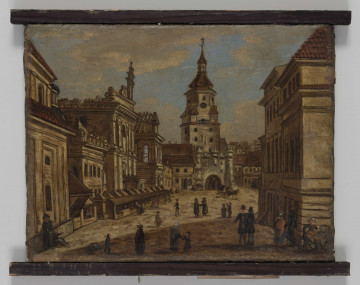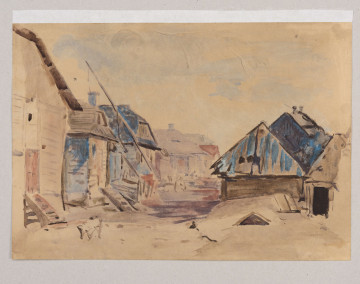
Krakow suburb
circa 1926-1939
National Museum in Lublin
Part of the collection: Lubliniana. Painting views of Lublin and the Lublin Region (17th–early 20th c.)
Władysław Skoczylas (1883-1934) is considered the initiator and creator of modern Polish woodcut, an artist who significantly influenced the popularity and development of this graphic discipline in Poland. Skoczylas studied painting at the Krakow Academy of Fine Arts under T. Axentowicz and L. Wyczółkowski and sculpture under K. Laszczek. In 1918 he became a professor of the Faculty of Architecture at the Warsaw University of Technology, and four years later he began teaching at the School of Fine Arts in Warsaw (later the Academy), where he headed the Department of Printmaking, educating successive generations of young woodcut students. He was a co-founder and member of the associations of Polish Artists “Rytm” and Graphic Artists “Ryt”. He became interested in printmaking as a mature artist, abandoning oil painting in its favour. He gained knowledge about the technique at the Academy of Graphic Arts in Leipzig. Skoczylas developed an individual character of woodcuts, referring stylistically to the folk art of Podhale, characterized by a flexible line full of precision. Through the presence of folklore inspiration in his work, he joined the search for a national style characteristic of the interwar period. In addition to the fascination with folklore, Skoczylas translated his interests into urban landscapes, using them as readily as the graphic medium - watercolour. One of the artist's favourite towns was Kazimierz Dolny on the Vistula River, where he came with his students to plein-air painting workshops since 1920. His views of the town are characterized by a variety of shots, in which his documentary ability to see is combined with a passion for individual shaping of the landscape. It was manifested in architectural fantasies, sometimes composed of freely compiled elements of the Kazimierz landscape. The view of the Hill of Three Crosses, the centrally located parish church and the butcher's shops, relocated from another part of the town, shows the artist's sense of form and compositional skill, manifested in the accumulation of plans.
Anna Hałata
Author / creator
Dimensions
cały obiekt: height: 58 cm, width: 44 cm
Object type
painting
Technique
painting technique
Material
paper, aquarel
Creation time / dating
Creation / finding place
Owner
The National Museum in Lublin
Identification number
Location / status

circa 1926-1939
National Museum in Lublin

1801 — 1900
National Museum in Lublin

1801 — 1900
National Museum in Lublin
DISCOVER this TOPIC
Museum of King Jan III's Palace at Wilanów
DISCOVER this PATH
Educational path